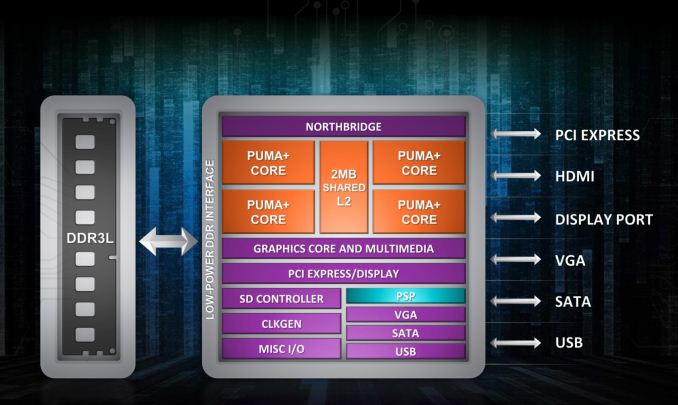AMD Beema/Mullins Architecture & Performance Preview
by Anand Lal Shimpi on April 29, 2014 12:00 AM ESTFinal Words
Despite no significant changes to the architecture or manufacturing process, AMD’s 2014 updates to its entry level and low power silicon are substantial. We finally have AMD silicon, built around a non-Bulldozer architecture, that seem to have turbo capabilities comparable to Intel’s. The result is a completely different performance profile. While AMD’s Jaguar cores in Kabini and Temash were easily outperformed by Intel’s Bay Trail, Puma+ pulls ahead. AMD continues to hold a substantial GPU performance advantage as well.
The gains in performance come while decreasing platform power. You can now have roughly the same performance as AMD offered last year in a 15W entry level notebook part, in a 4.5W TDP (2.8W SDP) tablet SKU. That’s seriously impressive.
The progress AMD made in a year with Beema and Mullins shows just how time constrained the team(s) were with bringing Kabini and Temash to market in 2013. While both of those SoCs were quite successful for AMD, I expect that at some point AMD won’t be allowed two years to fully polish a single design.
The big unknown is how these new SoCs stack up against Bay Trail when it comes to power consumption. From a performance standpoint at the very high end they are faster, but we’ll have to wait until we can get our hands on shipping devices before we know the full story when it comes to battery life. AMD expects to see Beema and Mullins designs show up over the next 1 - 2 quarters, with some designs shipping in the coming weeks to specific regions.
The other thing we need to see is a real Android strategy from AMD. Mullins seems like a good fit for a high performance Android tablet, but today AMD’s native OS strategy is exclusively Windows. I don’t think it’ll stay that way for long, but AMD has yet to give us any indication of when it’ll change.
And if I’m asking for things I want to see from AMD, you can add a PoP package and idle power that’s competitive with the likes of Apple and Qualcomm. AMD clearly came a long way over the past couple of years, but there’s still more progress to be made.











82 Comments
View All Comments
duploxxx - Tuesday, April 29, 2014 - link
Rival really here is intel, nowhere compared in this reviewssj3gohan - Tuesday, April 29, 2014 - link
You do realize that this is an AMD advertisement, not an actual journalistic article? Look at the top of the page: it says AMD Center.DanNeely - Tuesday, April 29, 2014 - link
Anything tagged AMD gets the AMD Center branding, regardless of the content (which's lead to an occasional giggle-snort situation in with articles that are 99% Intel/nVidia but mention AMD for comparison purposes). Look at the by line, this was written by Anand, not one of the AMD PR drones.mfoley93 - Wednesday, April 30, 2014 - link
There is also an Intel Center and nVIDIA Center that all articles about their respective products go in, does that make all articles about them advertisements as well?ruggia - Tuesday, April 29, 2014 - link
If you want a rough comparison with BayTrail, go check out the benchmarks at Toms' (or pull up Anand's old Kaveri articles). You'll be amazed.ruggia - Tuesday, April 29, 2014 - link
*Kabiniduploxxx - Friday, May 2, 2014 - link
there is info here and you see that it can very well compete with intel parts or even better in many parts. the problem is that many bench just wont run on the low end atom GPU wise :). you need the celeron version to compare performance to mullinAnand Lal Shimpi - Tuesday, April 29, 2014 - link
All of the CPU tests are compared to Intel parts, including the direct competitor: Intel's Bay Trail based Atom both in the ASUS Transformer Book T100 as well as numbers from Intel's Bay Trail tech day using the Atom Z3770.Stuka87 - Tuesday, April 29, 2014 - link
Intel chips are in several of the graphs, and is talked about specifically in several places.Did you even read the article?
MrSpadge - Tuesday, April 29, 2014 - link
A substantial performance increase over its predecessor is regressive? And if you insist comparing to AMDs big cores.. well, have fun putting these into a tablet!2x the power consumption? You seem to refer to idle power compared to Snapdragon 600, a SoC which is significantly slower and hence - just like the big cores - in a different category.
Beema / Mullins seems to occupy a very interesting point on the performance/power/price curves. It's obviously not for smartpones yet and neither for big gaming rigs. But for anything in between it's at least an intersting option.